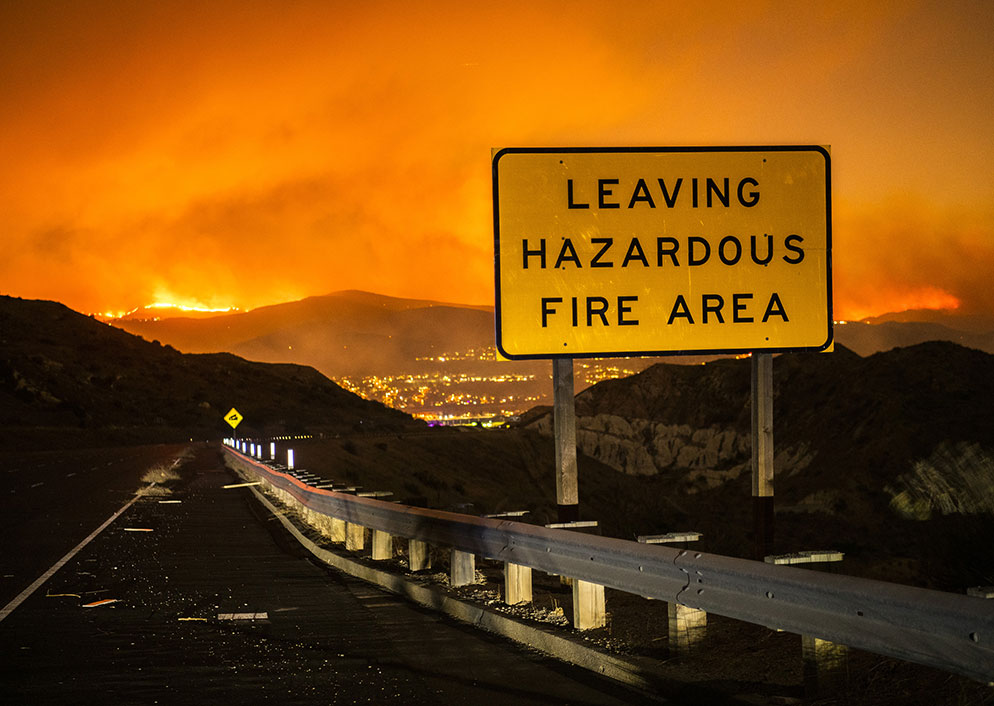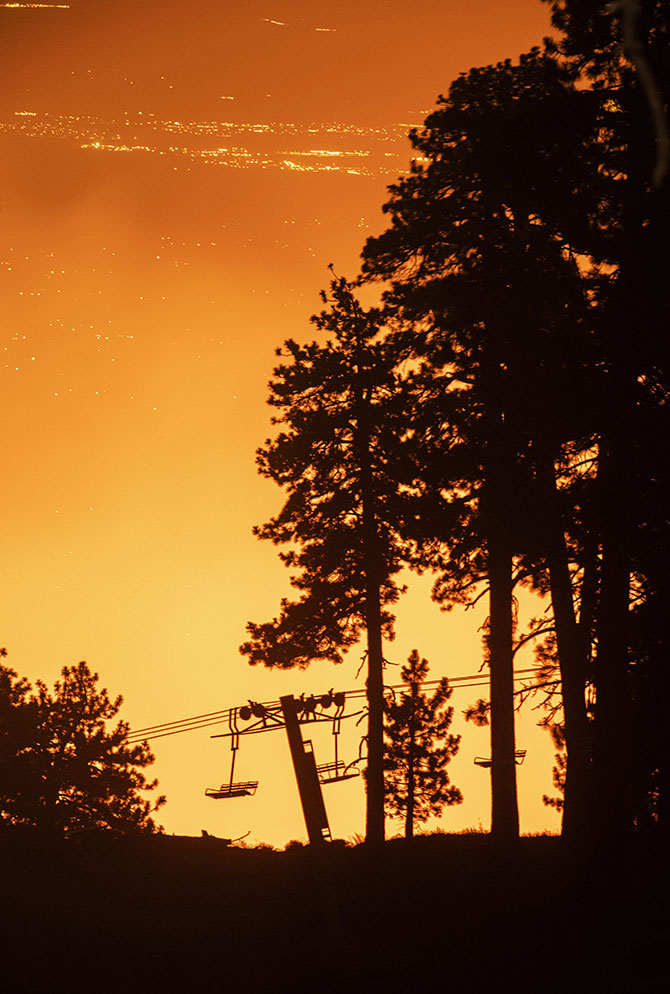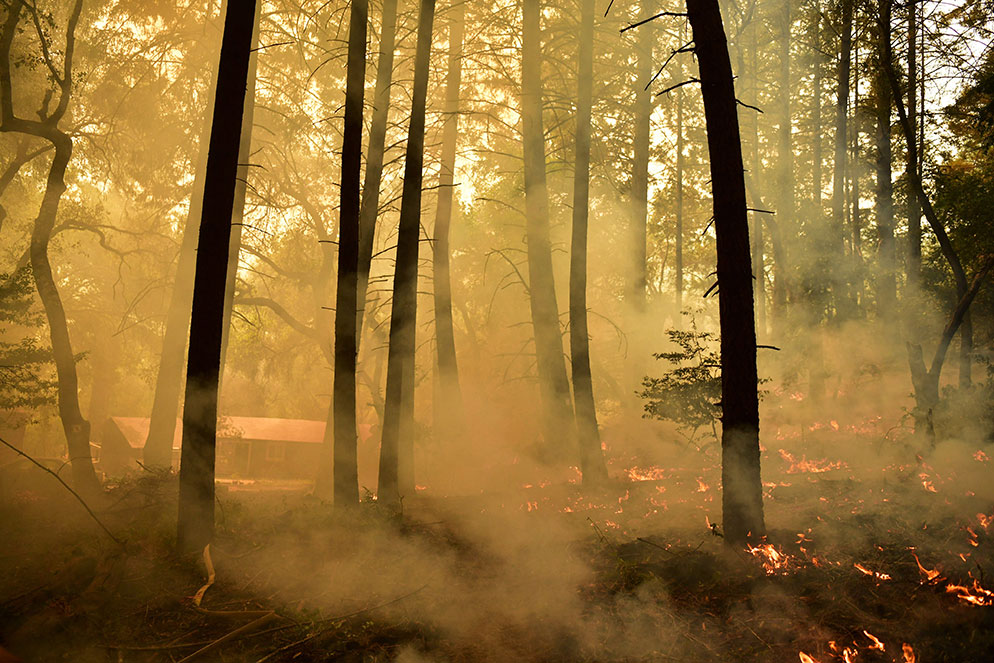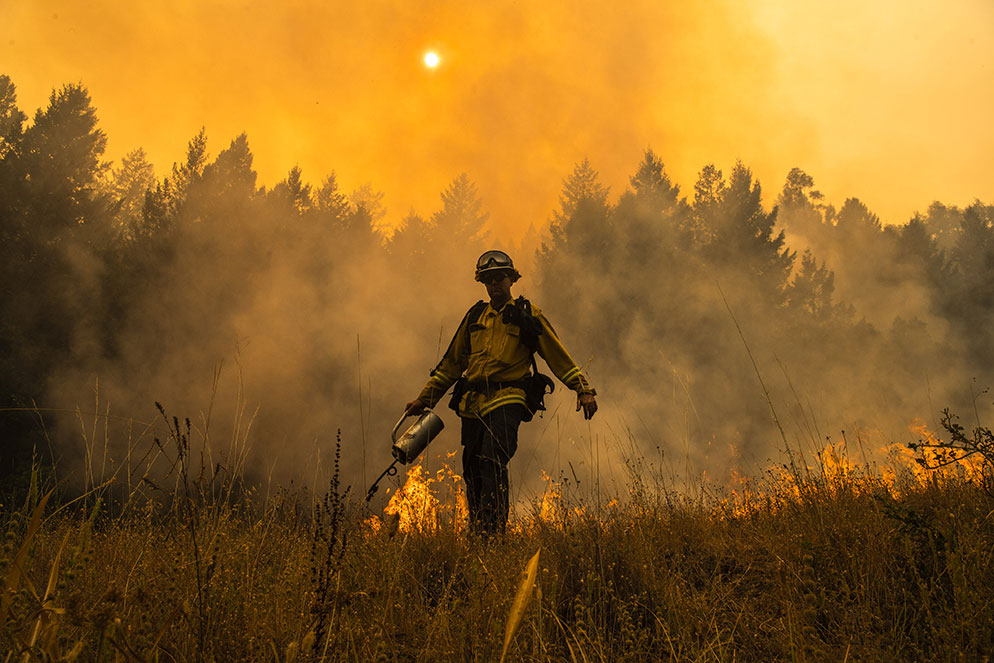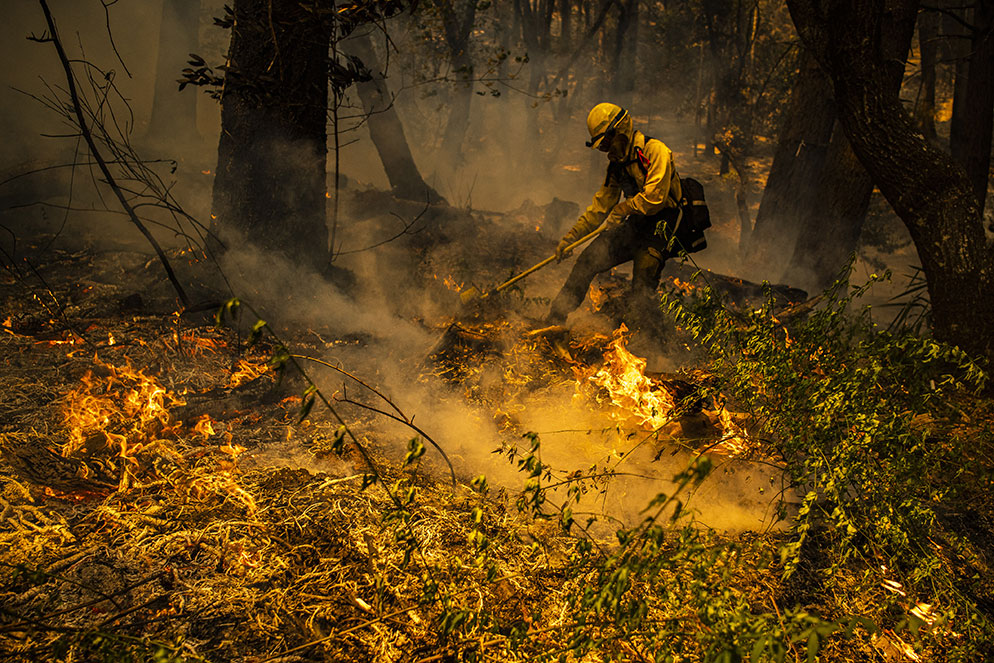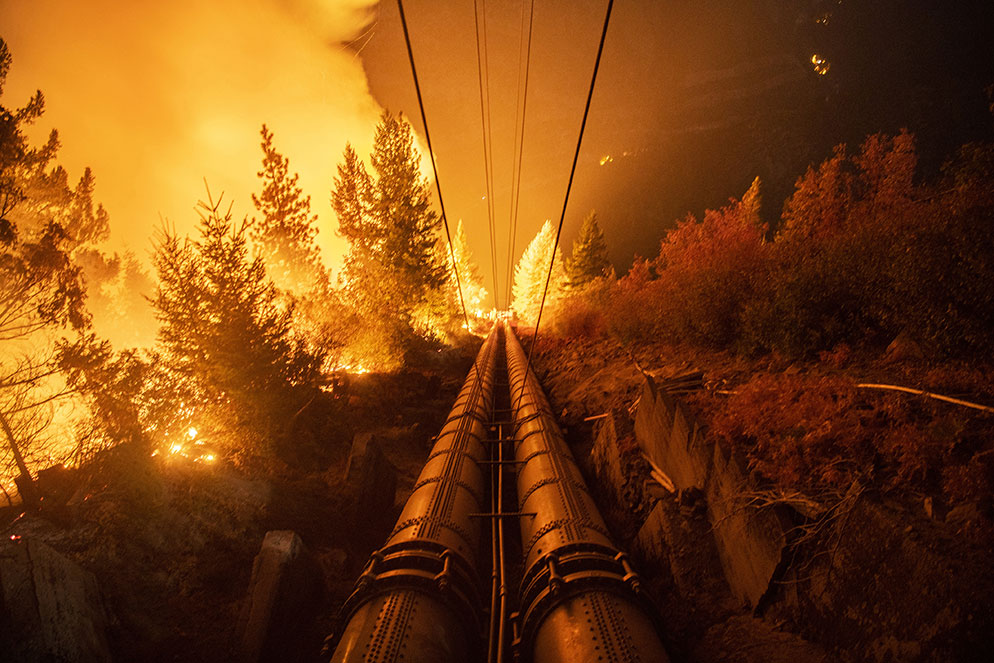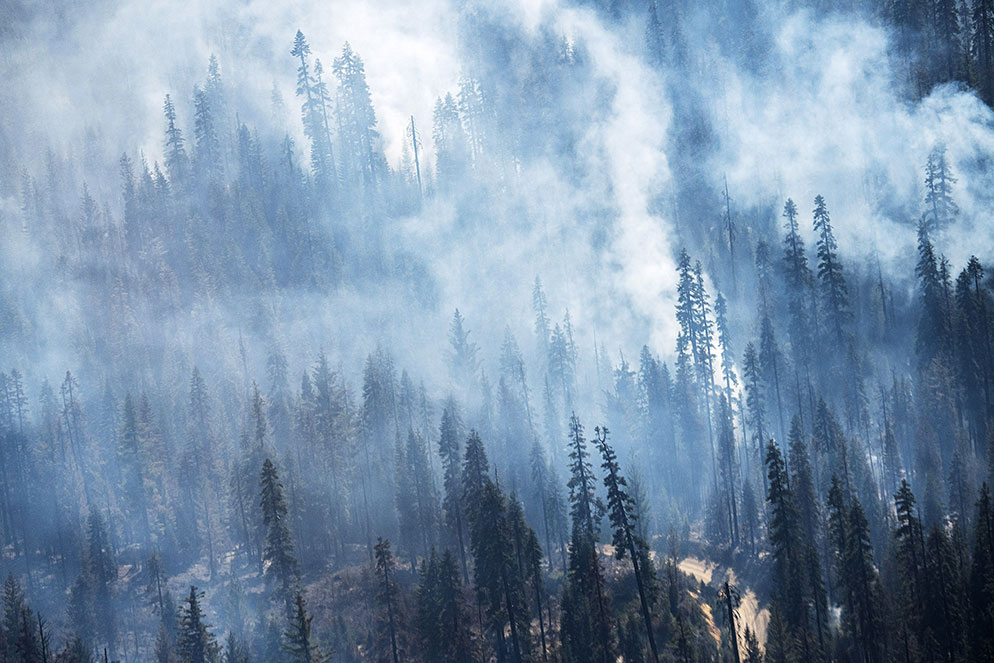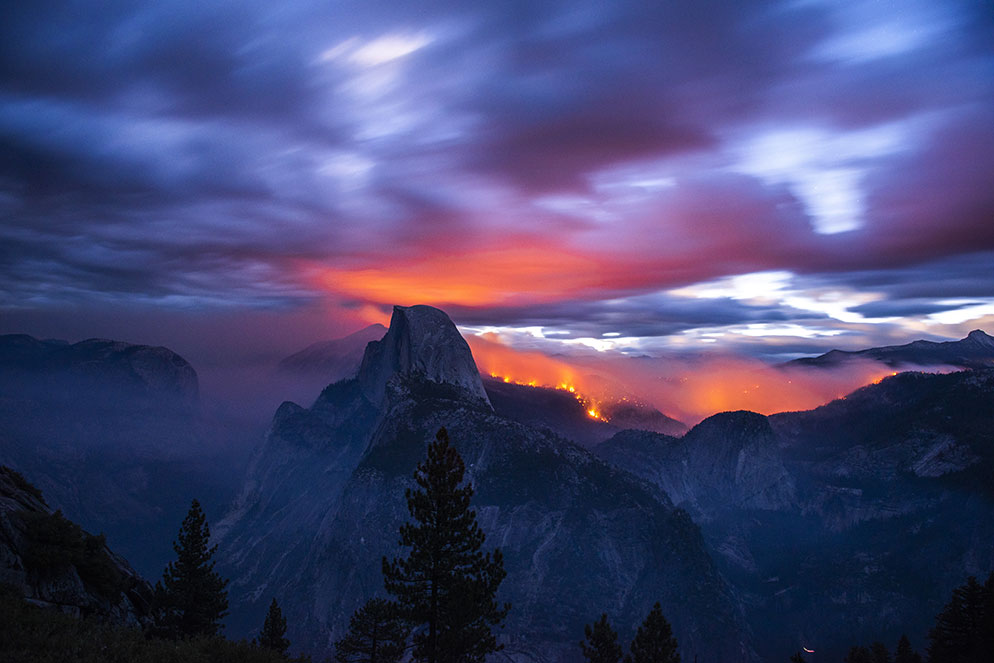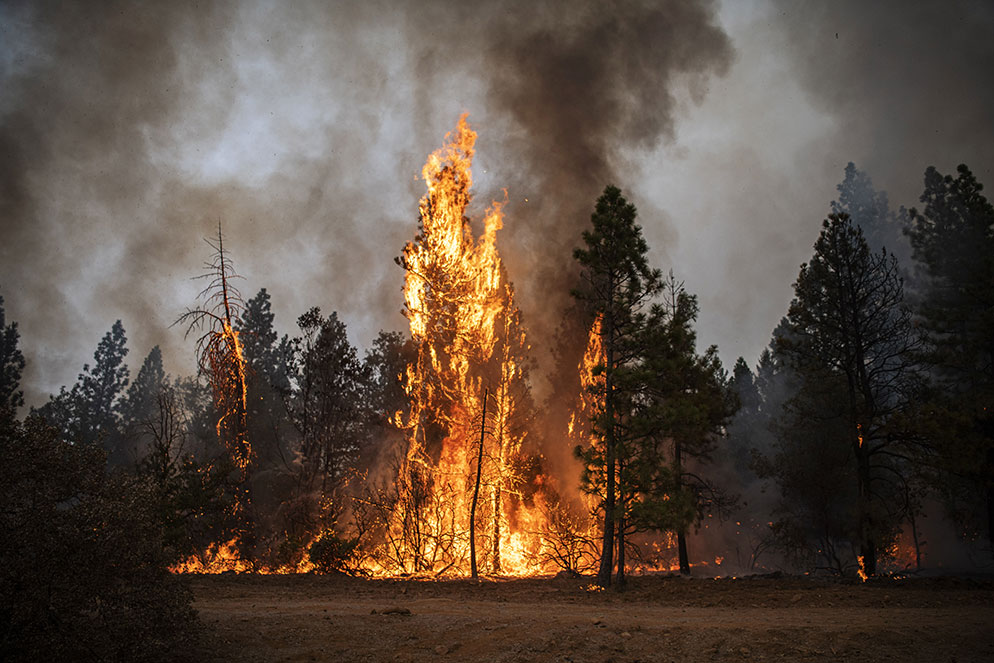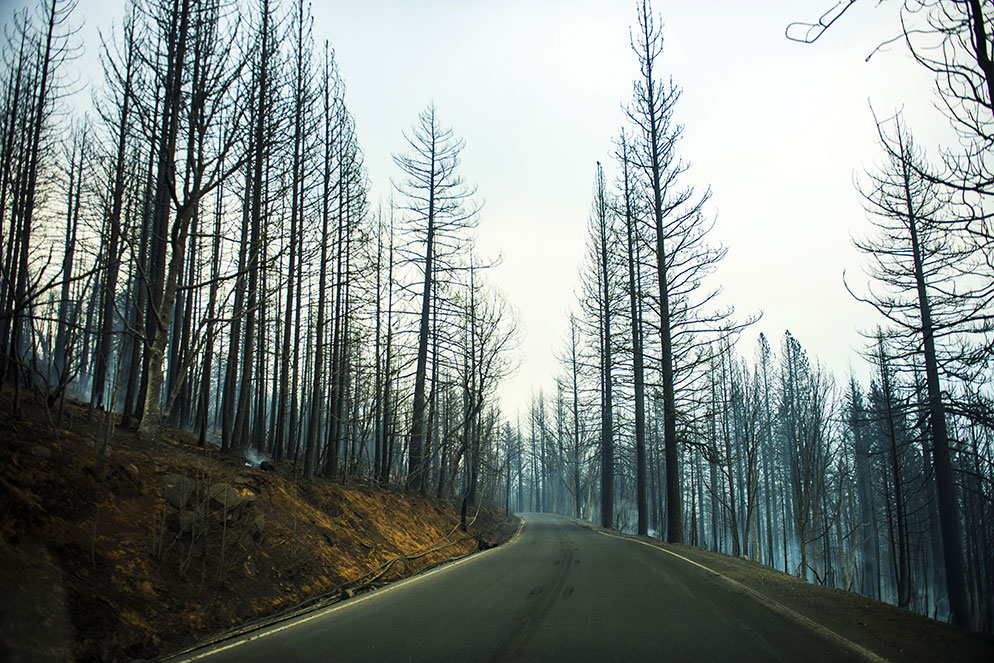Fire on the Mountain: Balancing the Risks and Rewards of Wildfire Photography
The North fire burned about 3,500 acres in San Bernardino County in July, 2015. Stuart framed this image to include the ski lift, and shot uphill to reveal the lights of Phelan, a town in the high desert. D810, AF-S NIKKOR 70-200mm f/2.8G ED VR II, 25 seconds, f/8, ISO 1600, manual exposure, Matrix metering.
There are a few things we want you to know about photojournalist and wildfire photographer Stuart Palley right from the start.
He talks fast and thinks faster, anticipating questions and often their follow-ups, and his answers expand the territory of the subject beyond the initial inquiry. He wants you to understand the before, during and after, and he knows what it takes to tell the whole, detailed story.
We mention this because all of the above exemplifies perfectly the state-of-mind, experience and preparation his photography requires. The dangers of wildfire photography demand constant awareness, acute observation and swift reaction amid the complexities of the moment.
"The biggest thing for me is safety," Stuart says. "That and staying out of the way of first responders and not becoming the story. Once those are covered, I go and make pictures."
Stuart's been photographing fires for about five years, making images for the U.S. Forest Service, on assignment for National Geographic and for his own project, Terra Flamma. His interest in wildfires grew from his concerns about conservation and the fact that the fires were figuratively, and sometimes literally, in the backyards of Los Angeles area residents. "The issues for me at first were drought and forest management," he says. Soon came a greater awareness. "Now I realize it's drought, forestry management, climate change and when, where and how we build. It's a collision of natural forces and human influences, and In many cases all these factors come together in mega fires."
During the Walbridge fire in Sonoma County in August, 2020, firefighters set a backburn to protect the home as the main body of the fire approached. D850, AF-S NIKKOR 24-70mm f/2.8E ED VR, 1/1600 second, f/2.8, ISO 800, aperture-priority exposure, Matrix metering.
Stuart's access to wildfires is due to his training and reliability. "I have a Red Card that's sponsored by the U.S. Forest Service," he says. "I'm a call-when-needed contractor for them." The Red Card is formally known as the Incident Qualification Card—it's an interagency certification that a person is qualified to be at the scene and on the job. "Call-when-needed essentially means I'm a freelancer for the Forest Service when they need photographers to help out on large incidents to assist the command team on public messaging. I have basic wildland training, which means I've learned to fight wildland fires on a basic level under close supervision, and my current classification is technical specialist, and my gear includes special fire boots, Nomex clothing, a fire helmet, a fire shelter, a radio—all the same things a wildland firefighter would have, but instead of running a hose or carrying a Pulaski, I use a camera."
A firefighter sets a controlled-burn backfire in an open field during the Walbridge fire. "A backburn is an effective strategy in many situations," Stuart says, "but it's not a strategy without risk." D850, AF-S NIKKOR 24-70mm f/2.8E ED VR, 1/500 second, f/13, ISO 400, aperture-priority exposure, Matrix metering.
"Controlling the intensity of a backburn is an art form," Stuart says. Here a firefighter uses a Rhino—a modified shovel—to rake out dense brush "to mellow out the fire, and put it out on the edge. Essentially he's contouring the backburn." A different form of fire control is achieved by the Pulaski, a dig-and-chop hand tool that combines an axe and an adze to clear an area as a firebreak. D850, AF-S NIKKOR 24-70mm f/2.8E ED VR, 1/2500 second, f/2.8, ISO 800, aperture-priority exposure, Matrix metering.
The Nature of a Wildfire
When we asked Stuart about the ironic aspect of taking dramatic story-telling images of a destructive force of nature, he homed in on the nature of the fire itself. "Fire, in itself, is its own irony. It is a destructive force, and it's also regenerative. Many ecosystems need fire to regenerate, to be healthy and remain in homeostasis. So fire is a powerful, beautiful, yet destructive force that upends lives, causes pain and tragedy and trauma, yet also is a natural rebalancing of ecosystems."
Implicit in his understanding of the nature of his work is respect for his subject and the danger it represents. "I always stay aware of my surroundings, and of the fire's behavior," he says. "I keep in mind that I'm not just taking pictures—I'm taking pictures while staying safe." Part of his awareness comes from his training. "I know I can do certain things and be reasonably safe because I understand fire's behavior. I know where the fire is going to be, what it's going to do, what it's going to look like under certain conditions. I'm using all that, and my knowledge of weather and fire operations, to create story-telling pictures."
The North Complex fire burns in Plumas National Forest in October, 2020. "The tube structure is called a penstock," Stuart says. "It carries water from mountain reservoirs down to a power station on the Feather River. The fire crews used the penstock as a fire break. On the left is the backburn operation that stopped the fire." D850, AF-S NIKKOR 24-70mm f/2.8E ED VR, 2 seconds, f/2.8, ISO 800, manual exposure, Matrix metering.
Not all his images capture the clear and present danger of wildfires. Some document the aftermath; others are taken from a distance. "People ask me all the time, 'How do you get into these fires?' Well, you don't. Not without training, not without equipment. Remember from The Lord of the Rings? 'One does not simply walk into Mordor.' It's not safe."
We would put it in even stronger terms: unless you are trained and experienced, do not even think of taking fireline pictures.
"A couple of times a day as a fire slows down the Forest Service will send up a helicopter on a reconnaissance flight to map hot spots and do damage surveys. This was on the North Complex fire, and I was in the jump seat. You're seeing an area where the fire burned a couple of days prior. It was still smoldering." D850, AF-S NIKKOR 80-400mm f/4.5-5.6G ED VR, 1/4000 second, f/7.1, ISO 640, aperture-priority exposure, Matrix metering.
"I like the idea of muscle-memory buttons; pick it up and go to work. Good equipment is a creative tool that gets out of your way. It just does what it's supposed to do to help you do your job."
The Blue Ridge fire in Yorba Linda, October, 2020. "I've driven this stretch of road hundreds of times," Stuart says. "It's a very active fire area, so I previsualized the photo years ago and kept it in my head. It's an ironic photo, but it's also about human boundaries. You're not out of the hazardous area; you're not safe no matter what the sign says." D850, AF-S NIKKOR 24-70mm f/2.8E ED VR, 1 second, f/2.8, ISO 1600, manual exposure, Matrix metering.
The Move to Mirrorless
The cameras that took the photos accompanying this story were Stuart's D810 and D850. "They were my workhorses for their combination of resolution, low noise and ruggedness. Ultimately, though, they're tools, and I'm a believer in having tools that are reliable and long-lasting."
Recently, though, the tools changed. "I'm now shooting almost exclusively with my Z 7. It's a wonderful camera for me—it’s light, small, with built-in image stability, incredible image quality and level of detail, edge to edge. The Z 7 with the 24-70mm f/2.8 lens is a great combo, so small I keep it in the glove box in a little pouch in my pickup truck. Whenever I’m driving and see something, I can pull over and I've got this super-high-resolution stabilized camera right there. And hiking around at night I'm able to use a smaller, lighter tripod because of the camera's stabilization."
After working with the Z 7 for two-plus years it's become a camera he doesn't have to think too much about. "I like the idea of muscle-memory buttons; pick it up and go to work. Good equipment is a creative tool that gets out of your way. It just does what it's supposed to do to help you do your job."
"Probably my personal favorite photo. It's the Meadow Fire, and that's Half Dome in Yosemite, pre-dawn, in September, 2014. You're seeing the reflection of flames on the low clouds. Lightning caused the fire, and about an hour after this photo was taken a thunderstorm blew in and put it out." D810, AF-S NIKKOR 24-70mm f/2.8E ED VR, 30 seconds, f/4, ISO 500, manual exposure, Matrix metering.
As far as techniques for wildfire photography, he keeps his methods locked into the demands of the situation. He frequently uses aperture-priority exposure to control depth of field and composition and lets high ISOs and fast lenses take care of the rest. "I prefer to shoot manual when it's possible," he adds, "but with fires, the way smoke moves and blocks out the light when the wind shifts, or for those times I have to walk five feet and don't have time to be calculating or eyeballing exposures, I could miss moments. In a fire area I can go from 1/400 second and ISO 200 at f/5.6 to 1/40 or 1/1600 in 20 feet. I find that the Matrix meter on the Nikon [cameras] and aperture priority give me really reliable results."
A backburn got a little hot at the Bear Fire, near Oroville, September, 2020. "It's called torching: when the fuels below a tree get preheated enough, the fire ignites and races up the tree. This was a pretty intense backburn. We had to walk back about 100 yards to stay away from the heat." D850, AF-S NIKKOR 24-70mm f/2.8E ED VR, 1/2500 second, f/2.8, ISO 250, aperture-priority exposure, Matrix metering.
The Terra Flamma Project
Stuart's pictures are documents of fire incidents—"what I saw and what it means"—and the goal of his Terra Flamma project—"I came up with my own rough Latin for 'earth on fire,'"—was, at first, to document California wildfires in long exposures at night. After his book, Terra Flamma: Wildfires at Night, was published in 2018, the project expanded "to include more on the human element, with a photojournalistic look at the work of the men and women on the fireline." A book of those images—"part narrative, part memoir"—is titled Into the Inferno: A Photographer's Journey Through California's Megafires and Fallout, is about a year away from publication.
Stuart took this two days after the Valley Fire burned in northern California in 2015. "It was drizzling, and the fire was still smoldering, and it created this sad scene along the road. Trees can smolder for days and then just fall over, so you have to be careful if you're among them." D810, AF-S NIKKOR 24-70mm f/2.8E ED VR, 1/2500 second, f/2.8, ISO 400, aperture-priority exposure, Matrix metering.

